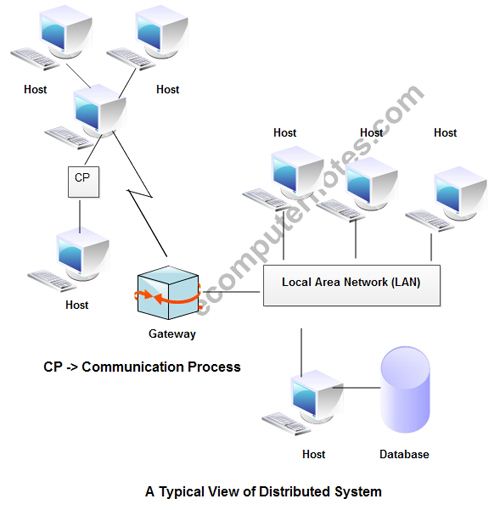Distributed Operating System is a model where distributed applications are running on multiple computers linked by communications. A distributed operating system is an extension of the network operating system that supports higher levels of communication and integration of the machines on the network.
This system looks to its users like an ordinary centralized operating system but runs on multiple, independent central processing units (CPUs).

These systems are referred as loosely coupled systems where each processor has its own local memory and processors communicate with one another through various communication lines, such as high speed buses or telephone lines. By loosely coupled systems, we mean that such computers possess no hardware connections at the CPU – memory bus level, but are connected by external interfaces that run under the control of software.
The Distributed Os involves a collection of autonomous computer systems, capable of communicating and cooperating with each other through a LAN / WAN. A Distributed Os provides a virtual machine abstraction to its users and wide sharing of resources like as computational capacity, I/O and files etc.
The structure shown in fig contains a set of individual computer systems and workstations connected via communication systems, but by this structure we can not say it is a distributed system because it is the software, not the hardware, that determines whether a system is distributed or not.
The users of a true distributed system should not know, on which machine their programs are running and where their files are stored. LOCUS and MICROS are the best examples of distributed operating systems.
Using LOCUS operating system it was possible to access local and distant files in uniform manner. This feature enabled a user to log on any node of the network and to utilize the resources in a network without the reference of his/her location. MICROS provided sharing of resources in an automatic manner. The jobs were assigned to different nodes of the whole system to balance the load on different nodes.
Below given are some of the examples of distributed operating systems:
l. IRIX operating system; is the implementation of UNIX System V, Release 3 for Silicon Graphics multiprocessor workstations.
2.DYNIX operating system running on Sequent Symmetry multiprocessor computers.
3.AIX operating system for IBM RS/6000 computers.
4.Solaris operating system for SUN multiprocessor workstations.
5.Mach/OS is a multi-threading and multitasking UNIX compatible operating system;
6.OSF/1 operating system developed by Open Foundation Software: UNIX compatible.
Distributed systems provide the following advantages:
1 Sharing of resources.
2 Reliability.
3 Communication.
4 Computation speedup
Distributed systems are potentially more reliable than a central system because if a system has only one instance of some critical component, such as a CPU, disk, or network interface, and that component fails, the system will go down. When there are multiple instances, the system may be able to continue in spite of occasional failures. In addition to hardware failures, one can also consider software failures. Distributed systems allow both hardware and software errors to be dealt with.
A distributed system is a set of computers that communicate and collaborate each other using software and hardware interconnecting components. Multiprocessors (MIMD computers using shared memory architecture), multi-computers connected through static or dynamic interconnection networks (MIMD computers using message passing architecture) and workstations connected through local area network are examples of such distributed systems.
A distributed system is managed by a distributed operating system. A distributed operating system manages the system shared resources used by multiple processes, the process scheduling activity (how processes are allocating on available processors), the communication and synchronization between running processes and so on. The software for parallel computers could be also tightly coupled or loosely coupled. The loosely coupled software allows computers and users of a distributed system to be independent each other but having a limited possibility to cooperate. An example of such a system is a group of computers connected through a local network. Every computer has its own memory, hard disk. There are some shared resources such files and printers. If the interconnection network broke down, individual computers could be used but without some features like printing to a non-local printer.
 Dinesh Thakur holds an B.C.A, MCDBA, MCSD certifications. Dinesh authors the hugely popular
Dinesh Thakur holds an B.C.A, MCDBA, MCSD certifications. Dinesh authors the hugely popular